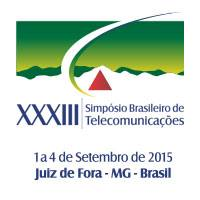
XXXIII Simpósio Brasileiro de Telecomunicações
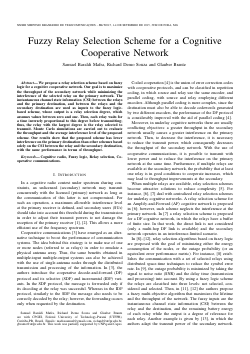
Fuzzy Relay Selection Scheme for a Cognitive Cooperative Network
Samuel Baraldi Mafra, Richard Demo Souza, Glauber Brante
DOI: 10.14209/sbrt.2015.161
Keywords: Cognitive radio Fuzzy logic Relay selection Co- operative communications
Abstract
We propose a relay selection scheme based on fuzzy logic for a cognitive cooperative network. Our goal is to maximize the throughput of the secondary network while minimizing the interference of the selected relay on the primary network. The instantaneous channel state information (CSI) between the relays and the primary destination, and between the relays and the secondary destination are used as inputs to the fuzzy logic- based scheme, whose output is a relay selection degree, which assumes values between zero and one. Then, each relay waits for a time inversely proportional to this degree before transmitting; thus, the relay with the largest degree is the relay selected to transmit. Monte Carlo simulations are carried out to evaluate the throughput and the average interference level of the proposed scheme. Our results show that the proposed scheme has lower interference on the primary destination than other schemes based solely on the CSI between the relay and the secondary destination, with the same performance in terms of throughput.Download

Sistema de Carregamento Sem Fio de Baixo Custo Utilizando Acoplamento Ressonante Indutivo
Levi Moreira de Albuquerque, Sheyla Rodrigues Rabelo, João Paulo Soares de Sousa, Paula Mayara Silva de Albuquerque, Pedro Klécius Farias Cardoso, Dr.
DOI: 10.14209/sbrt.2015.170
Keywords: Wireless charging magnetic resonant coupling electromagnetism
Abstract
This article describes the development of a wireless charging system using the inductive resonant coupling technique. The main aim of this system is the creation of a smart wireless power transmitter that could be inserted into various kinds of surfaces as to enable them to transmit energy wirelessly. Complementarily, the idealized system should have a receptor of reduced size as to be inserted into mobile devices so they can be charged by the described surfaces.Download

A First Discussion About Digital Filters for Clustered-OFDM Scheme in PLC Systems
Hugo V. Schettino, Moisés V. Ribeiro
DOI: 10.14209/sbrt.2015.162
Keywords: digital filter orthogonal frequency division multi- plexing interpolated finite impulse response filter infinite impulse response filter power line communication
Abstract
This work aims to investigate the suitability of finite impulse response and infinite impulse response digital filters for separating the clusters in a clustered Orthogonal Frequency Division Multiplexing schemes for power line communication systems. In this regards, we formulate the mathematical problem associated with issue. In the following, we shortly describe several digital filters that may be useful to fulfill the constraints asso- ciated with the problem. Based on numerical results and given digital filter design specifications, we reveal that the Chebyshev Type I and elliptic filters show the best trade of among signal noise ratio, date-rate, computational complexity (number of non- zero multipliers).Download

Cifragem de Imagens Baseada na Transformada Fracional de Fourier sobre Corpos Finitos
Paulo H. E. S. Lima, Juliano B. Lima, Ricardo M. Campello de Souza
DOI: 10.14209/sbrt.2015.171
Keywords: Fractional Fourier transforms Finite fields Image encryption
Abstract
The fractional Fourier transform over finite fields (GFrFT) based on the matrix function approach is used to design an image encryption scheme. The approach is simpler than the approach based on the construction of an eigenvector set, therefore allowing lower-cost computation systems. The scheme is a secret-key block cipher, that uses a confusion-diffusion architecture and the GFrFT for image encryption. Computer simulations are performed in order to analyze security aspects. A theoretical analysis and security metrics are used to evaluate the scheme security.Download

Improvement on Sampling Clock Offset Estimation for Mobile OFDM Systems
Davi A. L. Castro, Cristiano M. Panazio, Cássio F. Dantas
DOI: 10.14209/sbrt.2015.172
Keywords: OFDM Sampling Clock Offset Sampling Fre- quency Offset Time-varying Channels Doppler spread ISDB-T system
Abstract
Sampling Clock Offset (SCO) estimation is an important issue in Orthogonal Frequency-Division Multiplexing (OFDM) systems because sampling frequency mismatch between the transmitter and the receiver may severely degrade the system performance due to the loss of orthogonality between the subcarriers. SCO estimation in mobile environment is quite challenging since channel variation leads to an additional phase rotation that masks the SCO effects. However, most of the existing techniques rely on the assumption of a time-invariant channel and become considerably inaccurate in a mobile environment. In this paper, we propose an improvement to an existing pilot- aided SCO estimator aiming to provide robustness to channel variations. Performance was evaluated through simulations in a ISDB-T (Integrated Services Digital Broadcasting Terrestrial) compliant system, and the results have shown a considerable RMSE reduction for all ranges of SNR, specially for higher Doppler spread.Download
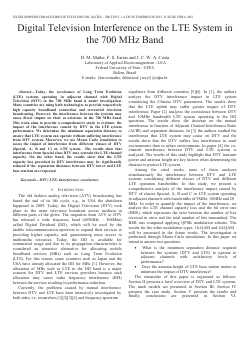
Digital Television Interference on the LTE System in the 700 MHz Band
D. M. Mathe, F. S. Farias, J. C. W. A. Costa
DOI: 10.14209/sbrt.2015.182
Keywords: DTV LTE Interference coexistence
Abstract
Today, the coexistence of Long Term Evolution (LTE) systems operating in adjacent channel with Digital Television (DTV) in the 700 MHz band is under investigation. Many countries are using both technologies to provide respectively high capacity broadband connection and terrestrial television broadcasting. However, the interference between the systems may cause direct impact on their co-existence in the 700 MHz band. This work aims to provide a comprehensive study to evaluate the impact of the interference caused by DTV in the LTE system performance. We determine the minimum separation distance to ensure that LTE system can operate without suffering interference from DTV system. Moreover, we use Monte Carlo simulation to assess the impact of interference from different classes of DTV (Special, A, B and C) on LTE system. The results show that interference from Special class DTV may restrain the LTE channel capacity. On the other hand, the results show that the LTE capacity loss provoked by DTV interference may be significantly reduced if the separation distances between DTV tower and LTE base stations are respected.Download
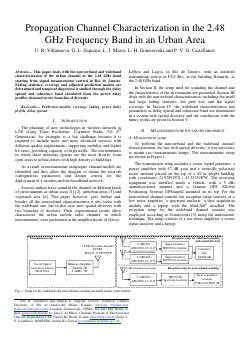
Propagation Channel Characterization in the 2.48 GHz Frequency Band in an Urban Area
U. R. Villanueva, G. L. Siqueira, L. J. Matos, L. H. Gonsioroski, P. V. G. Castellanos
DOI: 10.14209/sbrt.2015.23
Keywords: Prediction models coverage fading power delay profile delay spread
Abstract
This paper deals with the narrowband and wideband characterization of the urban channel in the 2.48 GHz band starting from signal measurements carried in Rio de Janeiro. Fading statistics, coverage and adjusted prediction models are determined and temporal dispersion is studied through the delay spread and coherence band calculated from the power delay profiles obtained in two branches of diversity.Download

Estudo de Antenas Ressoadoras Dielétricas Baseadas em FeNbTiO6 (ZnO)X para Aplicação em Dispositivos de Microondas
J. E. V. de Morais, A. J. C. Neves, M. A. S. Silva, D. B. da Costa, D. G. Sousa, J. Chaves, A. S. B. Sombra
DOI: 10.14209/sbrt.2015.25
Keywords: DRA FNTO permissividade diagrama de radiação perda de retorno.
Abstract
Neste trabalho é realizado um estudo de antenas ressoadoras dielétricas (DRA) da matriz cerâmica FeNbTiO6 (FNTO). Para tal, as amostras são adicionadas com ZnO nas seguintes proporções 0%, 8%, 16% e 25%. As propriedades dielétricas de micro-ondas apresentaram permissividade entre 47,23 e 63,77, além de um aumento das perdas dielétricas. Observou-se também através dos resultados que o coeficiente de temperatura da frequência ressonante (τf) decresceu a medida que a concentração de Zno aumentou, tendendo a uma maior estabilidade térmica. Além disso, resultados de simulação para a perda de retorno e diagramas de radiação mostraram que as amostras funcionam de forma eficiente como DRA na faixa de 2,2 GHz a 2,6 GHz. Com a melhora das propriedades dielétricas devido a adição de ZnO, o trabalho com um maior número de aplicações em dispositivos de micro-ondas, especificamente DRA, torna-se viável.Download
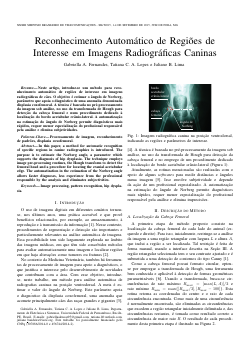
Reconhecimento Automático de Regiões de Interesse em Imagens Radiográficas Caninas
Gabriella A. Fernandes, Tatiana C. A. Lopes, Juliano B. Lima
DOI: 10.14209/sbrt.2015.26
Keywords: Processamento de imagem reconhecimento de padrões displasia coxofemoral
Abstract
Neste artigo, introduz-se um método para reconhecimento automático de regiões de interesse em imagens radiográficas de cães. O objetivo é estimar o ângulo de Norberg, parâmetro que apoia o diagnóstico de uma anomalia denominada displasia coxofemoral. A técnica é baseada no pré-processamento da imagem sob análise, no uso da transformada de Hough para detecção da cabeça femoral e num procedimento dedicado à localização do bordo acetabular crânio-lateral. A automatização na estimação do ângulo de Norberg permite diagnósticos mais rápidos, requer menor especialização do profissional responsável pela análise e elimina subjetividades.Download
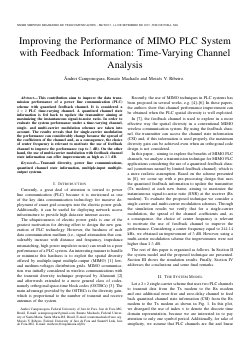
Improving the Performance of MIMO PLC System with Feedback Information: Time-Varying Channel Analysis
Ândrei Camponogara, Renato Machado, Moisés V. Ribeiro.
DOI: 10.14209/sbrt.2015.37
Keywords: Transmit diversity power line communications quantized channel state information multiple-input multipleoutput systems
Abstract
This contribution aims to improve the data transmission performance of a power line communication (PLC) scheme with quantized feedback channel. It is considered a 2 × 2 PLC time-varying channel. A quantized channel state information is fed back to update the transmitter aiming at maximizing the instantaneous signal-to-noise ratio. In order to evaluate the system performance under a time-varying channel, single- and multi-carrier modulation schemes are taken into account. The results reveals that for single-carrier modulation the performance can considerably change because the spread of the coefficients of the channel and, as a consequence, the choice of center frequency is relevant to motivate the use of feedback channel to improve the performance (up to 5 dB). On the other hand, the use of multi-carrier modulation with feedback channel state information can offer improvements as high as 2.5 dB.Download